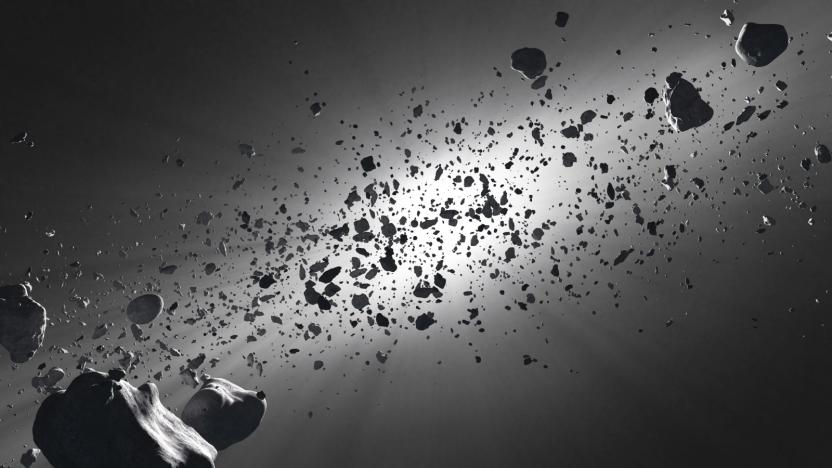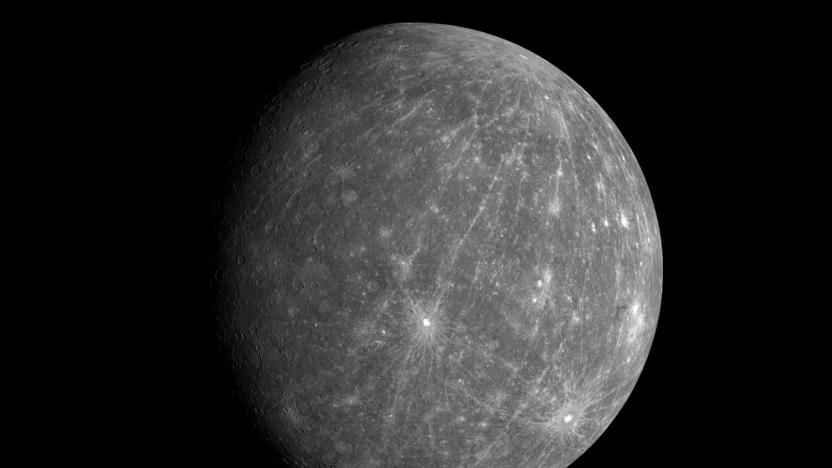spectrometer
Latest

OSIRIS-REx spacecraft already found water on its target asteroid
It didn't take long for NASA's OSIRIS-REx spacecraft to glean valuable insights from the asteroid Bennu. The vessel has helped scientists discover water trapped inside Bennu's clays thanks to its two spectrometers, which spotted the hydroxyls (bonded hydrogen and oxygen atoms) that indicate interaction with water. Researchers believe Bennu's parent astroid hosted liquid water at one point, and these traces carried over to the smaller space rock.

Water could be extracted all over the Moon, not just at its poles
If we're ever going to colonize another world, we can't rely solely on the supplies we bring with us. We'll have to make use of the resources available at our destination, with water being one of the most important. Not only can we drink it, but add a bit of science and voilà! You've got oxygen to breathe or rocket fuel to fly. Figuring out what resources are where is extremely important, and we've been honing this craft by looking at our celestial ally, the Moon. A study published last year suggested that water may exist in high quantities in the lunar interior, and now researchers have found evidence of water being distributed across the entire satellite, which is at odds with the widely held theory it's concentrated in the colder spots at the Moon's poles.

Scientists want to explore asteroids with a fleet of nanoprobes
Researchers at the Finnish Meteorological Institute (FMI) presented a mission plan today at the European Planetary Science Congress that would allow scientists to observe hundreds of asteroids over the course of just a few years. Their plan is to send 50 nanoprobes -- small space instruments -- into the asteroid belt that lies between Mars and Jupiter to take images and chemical measurements of around 300 large asteroids. "Asteroids are very diverse and, to date, we've only seen a small number at close range. To understand them better, we need to study a large number in situ. The only way to do this affordably is by using small spacecraft," FMI's Pekka Janhunen told Popular Mechanics.

$550 dock turns a smartphone into a medical lab
Smartphones can now be used as laboratory-grade medical testing devices thanks to new kit designed by the University of Illinois. The transmission-reflectance-intensity (TRI) analyzer attaches to a smartphone to examine blood, urine or saliva samples as reliably as large, expensive equipment, but costs just $550. The technology uses a high-performance spectrometer. First, a fluid sample is illuminated by the phone's internal white LED flash, then the light is collected in an optical fiber. The light is then guided through a diffraction grating into the phone's rear-facing camera, and a reading is provided on-screen.

Here's why the surface of Mercury is so dark
For years, scientists have wondered why Mercury is so dark. It doesn't have as much iron and titanium as the Moon, so it should be brighter. A team at Johns Hopkins' Applied Physics Laboratory finally has the answer, though. Thanks to a spectral analysis of color images from NASA's Messenger probe, they've determined that carbon (specifically, graphite) is the probable culprit behind Mercury's dim look. Most likely, what you're seeing is the aftermath of the tiny planet growing up. As the young Mercury's magma ocean cooled 4.6 billion years ago, the graphite would have floated to the top and formed the original crust -- there just happens to be enough of it left to affect visibility.

Pluto gets rainbow-hued in NASA's latest images
Pluto may have been imaged six ways from Sunday, but it's clear that the New Horizons probe still has a few surprises up its sleeve. NASA has posted both a photo and a video showing how the spacecraft can produce vibrant colors from the seemingly drab-looking dwarf planet. The key is New Horizons' infrared spectrometer. Its linearly-varying filter produces a stained glass window effect as it looks for reflected chemicals, like in the clip you see below -- the dark bands come when Pluto's methane ice absorbs those materials. And when researchers plug the results into visible color channels, the result is the almost festive mix of red and green (with hints of blue) that you see above.

The farthest known galaxy is 13.2 billion years old
Scientists have long reckoned that the first galaxies came into being roughly 500 million to 1 billion years after the Big Bang, but finding these ancient celestial bodies is tricky when their light is so faint that even many specialized tools aren't up to the job. However, researchers have managed to spot a galaxy so old that it's making them question the established timeline for the universe. They've determined that the recently discovered EGS8p7 galaxy is a whopping 13.2 billion years old, making it both the farthest known galaxy to date and just 600 million years younger than the universe as we know it. Theoretically, it shouldn't be possible to see the galaxy at all -- in EGS8p7's era, space was supposed to be full of neutral hydrogen clouds that absorbed radiation and made galaxies invisible to later observers.

NASA picks the scientific tools it'll use to study Europa
NASA is convinced that Jupiter's moon Europa is worth visiting, and for good reason: its icy surface could be hiding a giant ocean friendly to life. The agency is going to need the right equipment if it's going to verify its theories, however, which is why it just chose nine instruments that will go aboard a Europa mission in 2020. The tools will use a mix of imaging, magnetometry, radar and spectrometry to study the frozen world's chemical composition and learn more about what's lurking out of view. While these gadgets won't completely eliminate the need for underwater probes and other landers, they could save scientists a lot of trouble (and expense) as they search for signs of organic material.

TellSpec identifies food ingredients and calories using science, magic
Some of us can't eat gluten, while others need to stay away from certain fats. Mealtime can be incredibly stressful for people with dietary restrictions -- especially when dining out -- since manufacturers aren't always required to report all ingredients, specifically when dealing with trace amounts. With frequent inaccuracies, counting calories is a whole 'nother ball game. A pocketable device called TellSpec may be an affordable solution for breaking down the ingredients in our meals consistently, and wherever we eat. The device is essentially a miniature spectrometer -- a device that can analyze materials (ingredients, in this case) by measuring properties of light. The gadget sends a list of ingredients and nutrition info to a companion smartphone app, making it easy to evaluate food quickly and efficiently. If you live to eat, you might not want TellSpec complicating the experience, but if you eat to live, this gadget seems like a fit. It's set to ship next August, with pre-orders at Indiegogo available for $150 beginning today.

Daily Update for May 28, 2013
It's the TUAW Daily Update, your source for Apple news in a convenient audio format. You'll get all the top Apple stories of the day in three to five minutes for a quick review of what's happening in the Apple world. You can listen to today's Apple stories by clicking the inline player (requires Flash) or the non-Flash link below. To subscribe to the podcast for daily listening through iTunes, click here. No Flash? Click here to listen. Subscribe via RSS

iPhone biosensor cradle brings us one step closer to having tricorders (video)
It seems like every day we're getting a little bit closer to having tricorders, and today's no exception. Researchers at the University of Illinois at Urbana-Champaign have designed hardware and software that turns the iPhone into a powerful biosensor that's useful for toxin and pathogen testing as well as medical diagnosis. The package consists of a cradle that contains an assortment of lenses and filters which line up with the handset's camera, along with an app that guides the user through the testing process. At the core of the device is a photonic crystal slide which basically turns the iPhone into a high-resolution spectrometer. While the cradle only contains about $200 worth of parts, it's just as accurate as laboratory equipment costing tens of thousands of dollars, with the added bonus of being hand-held. The team just received an NSF grant to explore other applications for the device and is working on a cradle for Android phones. Hit the break for a demo video and a peek into the future.

UCSB sensor sniffs explosives through microfluidics, might replace Rover at the airport (video)
We're sure that most sniffer dogs would rather be playing fetch than hunting for bombs in luggage. If UC Santa Barbara has its way with a new sensor, those canines will have a lot more free time on their hands. The device manages a snout-like sensitivity by concentrating molecules in microfluidic channels whose nanoparticles boost any spectral signatures when they're hit by a laser spectrometer. Although the main technology fits into a small chip, it can detect vapors from explosives and other materials at a level of one part per billion or better; that's enough to put those pups out of work. To that end, the university is very much bent on commercializing its efforts and has already licensed the method to SpectraFluidics. We may see the technology first on the battlefield when the research involves funding from DARPA and the US Army, but it's no big stretch to imagine the sensor checking for drugs and explosives at the airport -- without ever needing a kibble break.

iPhone 5 chemical study shows a green Apple, leaves room for improvement
Eventually, that shiny new iPhone 5 will have to meet its untimely end, whether it's in a landfill or (preferably) a recycling company's machinery. When it does, you'll at least be glad to know that Apple has kept the toxin levels down. HealthyStuff and iFixit have dissected the extra skinny smartphone and put it in the same "low concern" category for potential harm that's normally occupied by phones wearing their green credentials on their sleeves. Lest anyone rush to tell Greenpeace about the feat, just remember that there's a difference between proficiency at excising dangerous chemicals and getting rid of them completely: HealthyStuff still found small traces of bromine, chlorine, lead and mercury in the iPhone 5's construction, which could pose risks if the handset is ever broken apart or melted for scrap. Some concern also exists that the x-ray fluorescence spectrometer doesn't reveal the full extent of any toxic materials. Whether or not these remain sore points for you, the new iPhone is at least easier on the eco-friendly conscience than most of its peers.

Insert Coin: Public Lab DIY Spectrometer wants to be the 'Shazam of materials'
In Insert Coin, we look at an exciting new tech project that requires funding before it can hit production. If you'd like to pitch a project, please send us a tip with "Insert Coin" as the subject line. Spectrometers are a pretty invaluable piece of lab equipment. They make it rather simple to identify substances by analyzing the light that they absorb. Problem is, for the hobby scientist, they typically cost thousands of dollars. Jeffrey Yoo Warren's latest Kickstarter project aims to put these powerful tools in the hands of your average Joe, with an open-source DYI model, where the key ingredient is a shard of DVD-R. Using that piece of plastic in conjunction with black paper and a webcam, his $35 kit allows anyone to quickly and easily reveal the spectral fingerprint of any substance. There's even a $5 model that works in conjunction with a free Android app, turning your smartphone into a legit lab tool. The goal, ultimately, is to build up a library of substances that can easily be matched with samples caught in the wild -- in essence, to build a "Shazam for materials." The original inspiration was an effort to identify contaminants left behind by the BP oil spill, but Warren also touts its ability to reveal hidden dyes in laundry detergents and to differentiate wines or olive oils. For those with grander ambitions, a $300 pledge will score you a pre-built and calibrated desktop spectrometer, complete with pyrex dishes and a full spectrum lamp. To help fund this backyard (or back pocket) science revolution, hit up the source link.

NASA finds DNA components in meteorites, says they originated in space (video)
So, this is kinda wild: scientists at NASA have uncovered new evidence that DNA components found in meteorites can originate in space, lending new credence to the theory that life on Earth may have arisen from a pre-existing "kit" of materials delivered via asteroid. The discovery is outlined in a new paper from Dr. Michael Callahan, whose team of researchers closely analyzed samples from 12 different meteorites, using a mass spectrometer and liquid chromatography. In their samples, they found traces of adenine, guanine, and a variety of molecules known as nucleobase analogs -- including three that are rarely found on Earth. Scientists have long known that meteorites can contain DNA elements, but were unsure whether these materials actually originate in space. The presence of these three molecules, however, suggest that they do, potentially raising new questions about the dawn of life on Earth, and beyond. It's all quite heady, but steam ahead for a NASA video that might help clarify things, after the break.

Purdue researchers craft handheld chemical analyzer, likens Tricorder
Hot on the heels of being crowned the most prolific pirating university in the land, Purdue is donning its halo once again by kicking out yet another invention that will surely make the world a better place to reside. The Mini 10 prototype is a handheld chemical analyzer that its creators have likened to Star Trek's "Tricorder," and while the internal abilities should genuinely impress, we're handing out a round of golf claps for the uber-glitzy motif it's got going on. The sophisticated sensing system measures just 13.5- x 8.5- x 7.5-inches and weighs in at 22-pounds, which is around 30 times less than conventional mass spectrometers, and aside from its ability to be completely portable via battery power, it still sports the same sniffing capabilities as its mammoth-sized siblings. In order to cram such potent chemical sensing abilities into such a small package, a miniature mass spectrometer is "combined with a technique called desorption electrospray ionization (DESI)," and can display the chemical composition of materials in a "matter of minutes without harming the samples." Interestingly enough, the prototype has already analyzed garb, food, and actual cocaine, and while we're not quite sure when you'll be able to snatch one of these up to "check in" on your mischievous teen, a couple of Indiana-based firms are apparently already looking into commercialization options.Slashdot]

Mini-Z T-ray imaging device takes home the gold
We're all about giving golf claps where they're due, and a healthy round is certainly in order for Mr. Brian Schulkin. The doctoral student in physics developed a breakthrough terahertz imaging device, dubbed a T-ray, that has already demonstrated its ability to "detect cracks in space shuttle foam, image tumors in breast tissue, and spot counterfeit watermarks on paper currency." The Mini-Z marks the first time such a powerful device has become portable in nature, weighing just five pounds and taking up about as much space as your average laptop. Taking home the first Lemelson-Rensselaer Student Prize ($30,000), Schulkin explained that this device didn't pose the same health risks as typical X-rays, and unlike ultrasound, terahertz waves can provide images and spectroscopic information without contacting an object. As expected, the patent-pending technology is already up for licensing, and has already received quite a bit of fanfare and commercial interest from larger companies. So while you may never personally encounter Brian's earth-shattering invention, we're fairly sure this young lad's working days are already drawing nigh if he so chooses.[Via Physorg]









